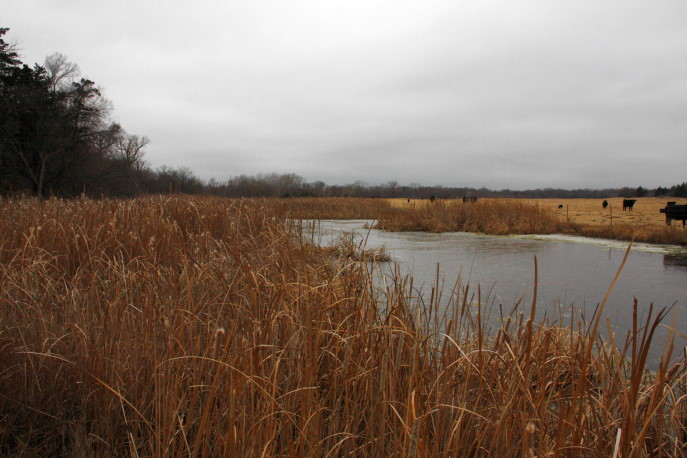
Agricultural News
New Conservation Studies Show Benefits for Upper Mississippi River Basin
Wed, 22 Jun 2016 13:11:10 CDT
 Researchers at the U.S. Geological Survey and the U.S. Department of Agriculture have published a new study that demonstrates that agricultural conservation practices in the upper Mississippi River watershed can reduce nitrogen inputs to area streams and rivers by as much as 34 percent.
Researchers at the U.S. Geological Survey and the U.S. Department of Agriculture have published a new study that demonstrates that agricultural conservation practices in the upper Mississippi River watershed can reduce nitrogen inputs to area streams and rivers by as much as 34 percent.
The study combined USDA's Conservation Effects Assessment Project (CEAP) data with the USGS SPARROW watershed model to measure the potential effects of voluntary conservation practices, which historically have been difficult to do in large river systems, because different nutrient sources can have overlapping influences on downstream water quality.
"These results provide new insights on the benefits of conservation practices in reducing nutrient inputs to local streams and rivers and ultimately to the Gulf of Mexico," said Sarah Ryker, Interior's acting assistant deputy for Water and Science. "The incorporation of agricultural conservation practice information into watershed models helps us better understand where water quality conditions are improving and prioritize where additional conservation actions are needed."
Until this study, nutrient reductions have been difficult to detect in the streams because changes in multiple sources of nutrients (including non-agricultural sources) and natural processes (e.g., hydrological variability, channel erosion) can have confounding influences that conceal the effects of improved farming practices on downstream water quality. The models used in this study overcame these difficulties to help validate the downstream benefits of farmers' conservation actions on the land.
"As the results of this valuable collaboration with the USGS indicate, voluntary conservation on agricultural lands is improving water quality. When multiple farmers, ranchers and working forest land managers in one region come together to apply the conservation science, the per acre conservation benefit is greatly enhanced," said USDA Natural Resources and Environment Deputy Under Secretary Ann Mills. "While there are no short-term solutions to complex water quality issues, USDA is committed to continuing these accelerated voluntary conservation efforts, using collaborative science to target conservation in watersheds where the greatest benefits can be realized."
Nutrient reductions attributable to agricultural conservation practices in the region ranged from five to 34 percent for nitrogen and from one to 10 percent for total phosphorus, according to the study published in the journal Environmental Science and Technology.
High levels of nutrients containing nitrogen and phosphorus from agricultural and urban areas contribute to hypoxic regions (low oxygen "dead zones") in offshore marine waters.
The study underscored evidence that slowing the water and routing it into the ground can significantly reduce the nitrogen that is eventually transported to streams. Structural and erosion control practices, such as conservation tillage, in the Upper Mississippi River Basin have been shown to reduce runoff and peak flows, thereby increasing water infiltration into the soils and the subsurface geology. An added benefit of these conservation actions is that, in some areas, hydrological and biogeochemical conditions in the subsurface can promote the removal of nitrogen by natural biological processes.
Phosphorus reductions were lower than was seen for nitrogen, possibly because of long time lags between conservation actions and the time it may take for sediment-bound phosphorus to move downstream. In addition, some erosion control practices, such as no-till and reduced tillage, have been shown to increase soluble phosphorus levels in farm runoff, which can potentially offset some benefits from erosion control practices.
The innovative approach combined information from process-based models from USDA's Agricultural Research Service and the Natural Resources Conservation Service (NRCS) with a USGS hybrid statistical and process-based model to quantify the environmental benefits of agricultural conservation practices at a regional scale.
The USGS watershed model was calibrated with data from over 700 water-quality monitoring stations operated by numerous local, state, and federal agencies throughout the Upper Mississippi River basin. The investigation used the most recently available farmer survey data from CEAP (2003-2006), together with stream water-quality data that are approximately coincident with the time period (1980s to 2004, with the average centered on 2002) over which farmer conservation practices, as measured in the survey, were adopted.
Additional information on the USGS SPARROW modeling approach and a nutrient mapper and an online decision support tool for the Mississippi River basin is available online.
USDA established CEAP to provide more quantitative science-based guidance on the benefits of conservation practices and identify further treatment needs. CEAP data have been useful in providing information and guidance on the best use of funding for conservation and to facilitate the alignment of conservation programs with national environmental protection priorities such as the restoration of the Gulf of Mexico.
Since 2009, USDA has invested more than $29 billion to help producers make conservation improvements, working with a record 500,000 farmers, ranchers and landowners to protect land and water on over 400 million acres nationwide. For an interactive look at USDA's work in conservation and forestry over the course of this Administration, visit USDA Results: Caring for our Air, Land and Water.
WebReadyTM Powered by WireReady® NSI
Top Agricultural News
More Headlines...




















